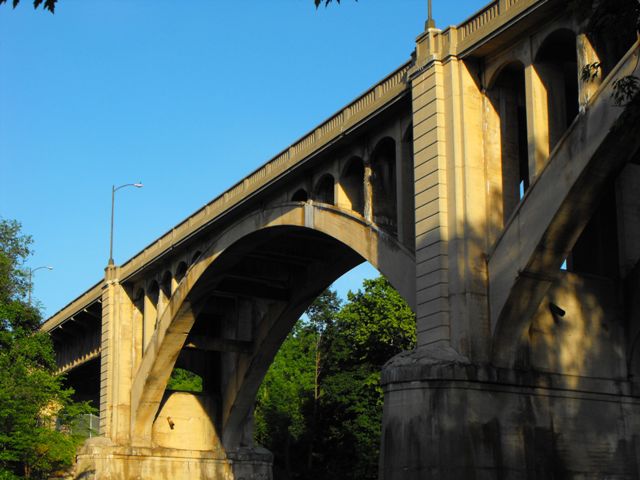We Recommend:
Bach Steel - Experts at historic truss bridge restoration.
BridgeHunter.com Phase 1 is released to the public! - Visit Now
Coplay-Northampton Bridge
Chestnut Street Bridge

Primary Photographer(s): Nathan Holth and Rick McOmber
Bridge Documented: May 30, 2010
Chestnut Street (PA-7404, 9th Street) Over Lehigh River and Railroad
Coplay and Northampton: Lehigh County, Pennsylvania and Northampton County, Pennsylvania: United States
Concrete Open Spandrel Deck Arch, Fixed and Approach Spans: Metal Continuous Rivet-Connected Parker Through Truss, Fixed
1930 By Builder/Contractor: Whitaker and Diehl of Harrisburg, Pennsylvania
1998
214.0 Feet (65.2 Meters)
1,124.0 Feet (342.6 Meters)
23.3 Feet (7.1 Meters)
3 Main Span(s) and 4 Approach Span(s)
39740400009002

View Information About HSR Ratings
Bridge Documentation
This bridge no longer exists!
Bridge Status: Demolished November 14, 2017.View Archived National Bridge Inventory Report - Has Additional Details and Evaluation
View Original Plans For This Bridge
View The Determination of Effect Report For The Demolition/Replacement Project
This bridge is an incredible structure that has a great deal of historic significance. From west to east, the bridge contains three concrete encased steel deck plate girder spans, three large open-spandrel concrete deck arch spans, and a single riveted Parker through truss span. Overall, the bridge retains excellent historic integrity. The bridge was rehabilitated in 1958 and 1998.
The truss span is unusual because it uses a large number of rolled beams, and is dissimilar to the standard through truss spans at use in Pennsylvania when this bridge was built. It is however similar to another bridge located in nearby Northampton County on Lynn Avenue. Also, the bottom chord and flooring system of the Coplay-Northampton Bridge truss span is encased in concrete. The truss span was built by the Bethlehem Steel Company, indicated by the separate plaque that the truss span has on the end post.
The deck plate girder spans are worthy of mention because they are encased in concrete. Concrete encasement was a short-lived trend that seems to have mostly occurred in the 1920s and 1930s.
The arch spans themselves which form the main part of the bridge are noteworthy not only for their integrity but for their landmark size. Long in span length and tall in height, these magnificent spans are more beautiful and impressive than any modern bridge could ever even dream of being.
Whitaker and Diehl was the main contractor for this bridge. Courtesy the Cumberland County, Pennsylvania digitized archives, a letterhead logo of the company is shown at the top of this narrative.
This bridge is owned by Lehigh County and the currently planned project to demolish and replace this important historic bridge was initiated by Lehigh County as well. So why is it that the fate of this bridge, despite available preservation alternatives and compromises, is so similar to those bridges in Pennsylvania that are owned by PennDOT? It may be because in Pennsylvania, PennDOT seems to play a larger and more influential role in providing guidance to, monitoring, and approving the bridge work that counties may undertake, compared to some other states. PennDOT is also involved in the conduct of the Section 106 process for a historic bridge, even when the county owns the bridge, and HistoricBridges.org has in the past found several fundamental problems with the way PennDOT conducts Section 106. Even though this is a county project, this bridge's planned demolition and replacement still points to a need for reform on the part of PennDOT.
One of the project needs identified when this project was proposed was the recreational use of the area, and the need for the Chestnut Street Bridge to function as a crossing for non-motorized traffic. This should not signal the need for a replacement bridge; rather it should signal a need for the rehabilitation of the historic bridge. The presence of trails on and around the bridge indicates a need to maintain the heritage and aesthetics of the bridge because the bridge would be a major attraction to the use of any trail system near the bridge. Indeed, one of the trail systems traces a railroad corridor that is eligible for the National Register of Historic Places. Thus, the trail already has a heritage theme, and so preserving the bridge would be important to continue and expand on that theme.
One particular problem with PennDOT regarding this bridge involves PennDOT's claim that a replacement bridge would be superior to rehabilitating the historic bridge because rehabilitation would only increase the life of the bridge for 50 years, while a replacement bridge would last 100 years. The 50 year estimate for rehabilitation might be accurate, and 50 years is quite a long period of time, and suggests that rehabilitation would be appropriate. However, PennDOT's claim that modern bridges will last 100 years is extremely misleading and not sufficiently substantiated by fact. When the Historic Bridge Foundation questioned the 100 year bridge life of a replacement bridge, PennDOT's rather snide comment was that the Historic Bridge Foundation should of all people know that a bridge can last 100 years. This comment reflects a fundamental lack of understanding about historic bridges on the part of PennDOT. Yes, historic bridges last 100 years, and they would last for 200 years if they were maintained and rehabilitated as needed. However, the materials used on historic bridges are different from modern bridge construction materials, so this is an inappropriate comparison. Modern bridges use new technologies such as pre-stressed concrete. Pre-stressed concrete did not begin to be used until the 1950s, and so even the oldest pre-stressed concrete bridges have not yet proven they can last 100 years. Also, the longevity of pre-stressed concrete can only be expected if there is to be a fundamental switch in policy from deferring bridge maintenance and repairs to actually conducting maintenance and repairs on bridges as problems first develop. Pre-stressed concrete in particular will deteriorate at an extremely rapid rate if even the smallest crack in the concrete exposes the tensioned tendons to moisture, causing corrosion of the tendons. Indeed, the number of 1960s and 1970s bridges that are being replaced or are in poor condition suggests that while modern bridge materials may be stronger at the outset, that they do not last very long. Another issue with modern bridges is the steel that is used. HistoricBridges.org has heard from several metal workers that modern steel, being composed of a large percentage of scrap steel, does not have the quality of virgin steel produced solely from ore, such as the steel used in historic bridges. HistoricBridges.org has not formally researched this claim, but it does seem likely to be true. The key point however is that to say modern bridges will last 100 years when the type of materials they are built with have not even been in use for 100 years yet is a bit presumptuous, and these life expectancy predictions should not be used to shoot down reasonable historic bridge preservation alternatives.
Information and Findings From Pennsylvania's Historic Bridge InventoryDiscussion of Bridge The 7 span, 1032'-long viaduct built in 1930 consists of three reinforced-concrete deck girders, three open spandrel arches, and a steel Parker thru truss. It is a joint county bridge over many transportation routes, including the National Register-listed Lehigh Canal and the determined eligible Lehigh Valley Railroad main line. The viaduct utilizes several important bridge technologies, including open spandrel arches for the main spans. It represents the a complicated engineering solution to a complex crossing, and, since it is complete, it is historically and technologically significant. The viaduct incorporates most of the bridge technologies for longer spans that were used in 1930. Discussion of Surrounding Area The bridge carries a 2 lane road over the Lehigh River between Coplay and Northampton. On the east bank of the river, the bridge spans over the abandoned Lehigh Canal and an active track of Conrail, the former Central RR of NJ established in the late 1860s. The right-of-way of the canal is a National Register-listed historic district with a period of significance from 1840 to 1931, the active years of the canal. On the west bank of the river, the bridge spans over the abandoned right-of-way of the former Lehigh Valley RR main line in a late-19th residential neighborhood in Coplay. The houses are significantly altered, and the area does not have historic district potential. The LV RR main line has been determined by PHMC to be a historic corridor. Bridge Considered Historic By Survey: Yes |
![]()
Photo Galleries and Videos: Coplay-Northampton Bridge
Bridge Photo-Documentation
Original / Full Size PhotosA collection of overview and detail photos. This gallery offers photos in the highest available resolution and file size in a touch-friendly popup viewer.
Alternatively, Browse Without Using Viewer
![]()
Bridge Photo-Documentation
Mobile Optimized PhotosA collection of overview and detail photos. This gallery features data-friendly, fast-loading photos in a touch-friendly popup viewer.
Alternatively, Browse Without Using Viewer
![]()
Westbound Crossing of the Bridge
Full Motion VideoStreaming video of the bridge. Also includes a higher quality downloadable video for greater clarity or offline viewing.
![]()
Maps and Links: Coplay-Northampton Bridge
This historic bridge has been demolished. This map is shown for reference purposes only.
Coordinates (Latitude, Longitude):
Search For Additional Bridge Listings:
Bridgehunter.com: View listed bridges within 0.5 miles (0.8 kilometers) of this bridge.
Bridgehunter.com: View listed bridges within 10 miles (16 kilometers) of this bridge.
Additional Maps:
Google Streetview (If Available)
GeoHack (Additional Links and Coordinates)
Apple Maps (Via DuckDuckGo Search)
Apple Maps (Apple devices only)
Android: Open Location In Your Map or GPS App
Flickr Gallery (Find Nearby Photos)
Wikimedia Commons (Find Nearby Photos)
Directions Via Sygic For Android
Directions Via Sygic For iOS and Android Dolphin Browser
USGS National Map (United States Only)
Historical USGS Topo Maps (United States Only)
Historic Aerials (United States Only)
CalTopo Maps (United States Only)



